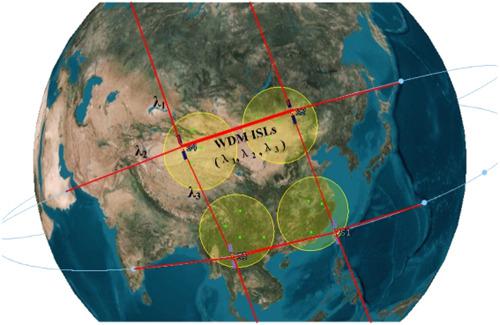当前位置:
X-MOL 学术
›
Int. J. Satell. Commun. Netw.
›
论文详情
Our official English website, www.x-mol.net, welcomes your feedback! (Note: you will need to create a separate account there.)
Separated traffic grooming for Low Earth Orbit (LEO) optical satellite networks with wavelength dimensioning
International Journal of Satellite Communications and Networking ( IF 1.7 ) Pub Date : 2020-07-06 , DOI: 10.1002/sat.1363 Cong Peng 1 , Shanghong Zhao 1 , Ruixin Li 1 , Jun Li 2 , Weilong Wang 1 , Hanghang Gao 1
International Journal of Satellite Communications and Networking ( IF 1.7 ) Pub Date : 2020-07-06 , DOI: 10.1002/sat.1363 Cong Peng 1 , Shanghong Zhao 1 , Ruixin Li 1 , Jun Li 2 , Weilong Wang 1 , Hanghang Gao 1
Affiliation

|
Intersatellite laser links have the advantages of high bandwidth, low delay, and low power consumption, which makes wavelength division multiplexing (WDM) with wavelength routing a promising alternative to accommodate the tremendous increasing traffics from terrestrial users. To make better use of the finite wavelengths in optical satellite networks (OSNs), traffic grooming is necessary for the sake of its inherent superiority in partitioning wavelength channel into multiple low‐rate channels to satisfy the traffic requests. However, in most occasions, wavelength dimensioning is taken as a part of traffic grooming, which increases the complexity of application. Therefore, this paper investigates a novel separated traffic grooming method to minimize the number of wavelengths while satisfying the traffic requests, of which the process can be divided into two parts. Firstly, the basic connection requests are bundled to construct aggregation units (AUs). And then, the AUs are groomed onto wavelengths. In the process, an AUs construction method with multihop lightpath bypass grooming (MHLBG) is designed for uniform traffics, and a bandwidth reorganization algorithm (BRA) with MHLBG is customized for nonuniform traffics. Finally, we evaluate performance in simulation, and the results show that the proposed method has realized a good compromise between numbers of wavelengths to be used with the average end‐to‐end delay. Also, the separated traffic grooming method yields better performance than the integrated one.
中文翻译:

具有波长尺寸的低地球轨道(LEO)光学卫星网络的分离流量疏导
卫星间激光链路具有高带宽,低延迟和低功耗的优点,这使得具有波长路由功能的波分复用(WDM)成为有希望的替代方案,可适应来自地面用户的大量业务增长。为了更好地利用光学卫星网络(OSN)中的有限波长,必须进行流量疏导,因为其固有的优越性是将波长信道划分为多个低速率信道以满足流量需求。但是,在大多数情况下,波长调整被视为流量疏导的一部分,这增加了应用程序的复杂性。因此,本文研究了一种新颖的分离式交通疏导方法,以在满足交通需求的同时最大程度地减少波长数量,其中过程可以分为两部分。首先,将基本连接请求捆绑在一起以构造聚合单元(AU)。然后,将AU修饰为波长。在此过程中,针对统一流量设计了具有多跳光路旁路修饰(MHLBG)的AUs构建方法,并针对非均匀流量定制了带有MHLBG的带宽重组算法(BRA)。最后,我们在仿真中评估了性能,结果表明,该方法已经实现了要使用的波长数与平均端到端延迟之间的良好折衷。而且,分离的流量疏导方法比集成的方法具有更好的性能。在此过程中,针对统一流量设计了具有多跳光路旁路修饰(MHLBG)的AUs构建方法,并针对非均匀流量定制了带有MHLBG的带宽重组算法(BRA)。最后,我们在仿真中评估了性能,结果表明,该方法已经实现了要使用的波长数与平均端到端延迟之间的良好折衷。而且,分离的流量疏导方法比集成的方法具有更好的性能。在此过程中,针对统一流量设计了具有多跳光路旁路修饰(MHLBG)的AUs构建方法,并针对非均匀流量定制了带有MHLBG的带宽重组算法(BRA)。最后,我们在仿真中评估了性能,结果表明,该方法已经实现了要使用的波长数与平均端到端延迟之间的良好折衷。而且,分离的流量疏导方法比集成的方法具有更好的性能。结果表明,所提出的方法已经实现了要使用的波长数与平均端到端延迟之间的良好折衷。而且,分离的流量疏导方法比集成的方法具有更好的性能。结果表明,所提出的方法已经实现了要使用的波长数与平均端到端延迟之间的良好折衷。而且,分离的流量疏导方法比集成的方法具有更好的性能。
更新日期:2020-07-06
中文翻译:

具有波长尺寸的低地球轨道(LEO)光学卫星网络的分离流量疏导
卫星间激光链路具有高带宽,低延迟和低功耗的优点,这使得具有波长路由功能的波分复用(WDM)成为有希望的替代方案,可适应来自地面用户的大量业务增长。为了更好地利用光学卫星网络(OSN)中的有限波长,必须进行流量疏导,因为其固有的优越性是将波长信道划分为多个低速率信道以满足流量需求。但是,在大多数情况下,波长调整被视为流量疏导的一部分,这增加了应用程序的复杂性。因此,本文研究了一种新颖的分离式交通疏导方法,以在满足交通需求的同时最大程度地减少波长数量,其中过程可以分为两部分。首先,将基本连接请求捆绑在一起以构造聚合单元(AU)。然后,将AU修饰为波长。在此过程中,针对统一流量设计了具有多跳光路旁路修饰(MHLBG)的AUs构建方法,并针对非均匀流量定制了带有MHLBG的带宽重组算法(BRA)。最后,我们在仿真中评估了性能,结果表明,该方法已经实现了要使用的波长数与平均端到端延迟之间的良好折衷。而且,分离的流量疏导方法比集成的方法具有更好的性能。在此过程中,针对统一流量设计了具有多跳光路旁路修饰(MHLBG)的AUs构建方法,并针对非均匀流量定制了带有MHLBG的带宽重组算法(BRA)。最后,我们在仿真中评估了性能,结果表明,该方法已经实现了要使用的波长数与平均端到端延迟之间的良好折衷。而且,分离的流量疏导方法比集成的方法具有更好的性能。在此过程中,针对统一流量设计了具有多跳光路旁路修饰(MHLBG)的AUs构建方法,并针对非均匀流量定制了带有MHLBG的带宽重组算法(BRA)。最后,我们在仿真中评估了性能,结果表明,该方法已经实现了要使用的波长数与平均端到端延迟之间的良好折衷。而且,分离的流量疏导方法比集成的方法具有更好的性能。结果表明,所提出的方法已经实现了要使用的波长数与平均端到端延迟之间的良好折衷。而且,分离的流量疏导方法比集成的方法具有更好的性能。结果表明,所提出的方法已经实现了要使用的波长数与平均端到端延迟之间的良好折衷。而且,分离的流量疏导方法比集成的方法具有更好的性能。



























 京公网安备 11010802027423号
京公网安备 11010802027423号